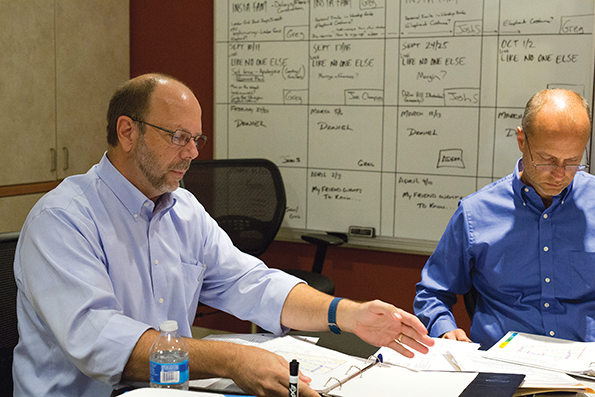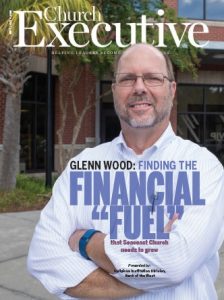
By RaeAnn Slaybaugh
![]() With 13 locations (and growing!), Seacoast Church’s vision proved to be beyond its previous financial partner’s comfort level.
With 13 locations (and growing!), Seacoast Church’s vision proved to be beyond its previous financial partner’s comfort level.
The challenge: find one that understands who the church is, what it wants to do, why… and how to make it happen.
Glenn Wood and his wife, Lisa, started attending Seacoast Church in 1991. They started volunteering right away.
In December 1995, Glenn joined the staff, bringing with him a career’s worth of business management experience — retail, logistics, purchasing, construction sales and sales management, and more.
“Looking back, all those positions and jobs roll in to what I do today, which is interesting,” he says. “Sitting here today, I can see how God used everything I learned as a blueprint for what I do today as church administrator at Seacoast.”
One of those tasks: finding a lending partner that understands — and can accommodate — the immediate and long-term financial needs at this unique, rapidly expanding, outside-the-box multisite-model church.
 Seacoast has 13 locations. But, I understand even more expansion plans are on the horizon. What do those look like?
Seacoast has 13 locations. But, I understand even more expansion plans are on the horizon. What do those look like?
Glenn: Since 2001, we’ve been moving full-speed towards multisite. We’ve been focusing on finding, expanding, moving and growing additional campuses.
But, we haven’t really done anything to expand the worship space at our original location — Mt. Pleasant — since 1998. We’re working on a 2,400-seat worship center right now.
Also, we recently moved a campus so it would have more space and foster more opportunities for ministry.
We’re constantly working on facility projects, both large and small.
 At some point, you say that your former banking partner “began to show discomfort with the size and scope of future projects.” How could you tell?
At some point, you say that your former banking partner “began to show discomfort with the size and scope of future projects.” How could you tell?
Glenn: We knew when the lender was unwilling to fund the purchase of a shopping center in which one of our larger campuses was housed. The owners were looking to sell the property, bulldoze it, and put up something else. We felt one option was to purchase the center, and then act as its landlord.
We discussed this with our former banking partner. After some amount of discussion, they said they were unwilling to fund the effort. As a church, we still felt like this was what we needed to do.
So, I made some phone calls and talked to some lenders I’d known over the years. We were looking for a new lending partner that would help us continue our ministry and partner with us, long-term.
We changed to the Bank of the West in 2015.
Why did you decide on Bank of the West?
Glenn: I’ve known [Executive Vice President and National Manager of the Religious Institution Division] Dan [Mikes] for about 15 years. And I’ve known our account manager, Jeremy [Moore] for about eight years.
Before they were our bank, we talked several times a year — at conferences, or when our paths crossed. That has given them time to see how we operate and who Seacoast is. They’ve taken the time to learn about our church’s mission, values and model. Doing that helped them develop more relevant banking services than we previously had.
In the early days of the multisite movement at Seacoast — back in 2002, 2003, 2004 — there were lenders who were basically not supportive of our lending requests.
Again, though, knowing [Dan and Jeremy] for as long as we have has helped them understand that multisite is working here, and why it’s working.

Before enlisting a new lending partner, how rapid was the expansion at Seacoast?
Glenn: Collectively, our church has grown between 5 percent and 15 percent every year for the past several years. Some of our satellite campuses have seen significantly larger annual growth of 20 percent to 40 percent.
Here again, growing pains — small and large — are just part of life at Seacoast, having embraced a multi-site ministry model. When a congregation expands rapidly, the financing challenges are magnified.
“A lot of banks have looked at Seacoast and compared it to their traditional church clients of 100 to 200 people. But, it’s important that a lending partner has a sense of how a large church operates. Not every bank understands the complexity. Add in multiple church locations, and a lot of banks don’t understand how those other campuses are going to be managed.”
— Glenn Wood
For smaller expansions, we preserve our cash for ministry where we can, where it makes sense. For a larger expansion (like the sanctuary addition we’re working on right now), we definitely need a banking partner that will help us invest and make those dreams a reality.

Seacoast is a seeker church. So, a lot of people who come to our campuses haven’t been walking with the Lord in recent years. That manifests itself in an unfamiliarity with giving to the church. They have kids, a mortgage and a car payment; often, they have very little margin to give to the church. Knowing this, for 28 years, we’ve provided facilities before they get to the point where they can help pay for them.
Even so, we’ve consistently seen that average giving per person — whether they attend a small campus or a large one — doesn’t vary a lot.
You’ve said that Seacoast Church is “different than for-profit businesses and most churches” in ways that a lending partner, uniquely, should understand. Please explain.
Glenn: While a church is a non-profit entity, it really has to be managed like a large, for-profit business — especially at Seacoast’s size. We have to manage our finances, and we have to set up budgets.
A lot of banks have looked at Seacoast and compared it to their traditional church clients of 100 to 200 people. But, it’s important that a lending partner has a sense of how a large church operates. Not every bank understands the complexity.
Add in multiple church locations, and a lot of banks don’t understand how those other campuses are going to be managed. One thing we’ve worked toward over the years is to centralize the ‘core services.’ All our banking, finances, payroll, IT, communications, outreach — they’re done in a central location, not at each individual campus. For our message, we formed a teaching team a number of years ago. We’re also blessed to have a speaking team.
Also, many banks think there is only one pastor per church, and that he’s involved in everything. At Seacoast, that’s not how we operate. We have a campus pastor at every campus whose No. 1 goal and No. 1 job is to love on the people. He doesn’t have to worry about paying the bills, getting employees paid, writing a weekend sermon, or balancing the checkbook. That’s because we’ve worked to centralize services and enjoy the economy of scale. We create consistency and manage all of that a lot better for him.
A lot of banks don’t understand that model. So, part of my job as the administrator, over the years, has been to try and find banks and partners that understand us and really want to come alongside and partner with us. Eventually, we found that in Bank of the West.
For many years, the bank has been the corporate sponsor for the annual national conference for The Church Network (TCN), formerly known as the National Association of Church Business Administration.
You credit the bank with looking beyond Seacoast’s immediate financing needs towards your “down-the-road” needs, and providing a pathway to accommodate those. Let’s talk about what that means.
Glenn: For one thing, we have peace of mind that we can move forward with the next project when the time comes. We’ve gone to Dan and Jeremy and said, ‘Here’s the need; here’s what we’re doing; here are the challenges we face; and here are the options we came up with.’
At the beginning of our financial partnership, as I mentioned, the immediate needs were to finance a shopping center purchase and an expansion of our largest campus. Within two weeks, we went from an initial meeting to discuss these needs, to the bank bringing us a proposal that sent a clear message: We want to partner with you.
Yes, we’ll provide the funding for you to buy the shopping center.
Yes, we’ll take on your existing debt.
You also qualify for the funding needed for your construction project.
And keep in mind that we didn’t even have a firm price for the facility expansion project at the time. The blueprints weren’t done. It was a conceptual proposal. A lot of assumptions were made, on their end and on ours.
Regardless, they were willing to help us look at the big picture, which was a tremendous comfort. We were able to go to our board of trustees and debt team and say, ‘Hey, guys, here’s the plan: They want to fund the shopping center; here’s how they restructured that deal. By the way, it’s the best deal proposed among the four banks I was talking with at the time, and it has the most flexible structure.’
At the same time, they wanted to partner with us on the
sanctuary expansion.
All this means that a year from now, we won’t have to go out and find another bank.
In what ways has your church been able to manage long-term interest rate risk while maintaining the flexibility to prepay debt, without risk of incurring a penalty?
Glenn: With the shopping center, [Bank of the West] came in and said, ‘Hey, we understand you want to buy the shopping center. We also understand you don’t want to be in the landlord business, long-term.’ So, we talked about subdividing the property — the church can maintain the property it sits on, and then sell the balance of the shopping center to another company.
To make that happen, they said, ‘You can have multiple rates and multiple terms.’ They gave us a lot of flexibility to structure the loan the way it makes the most sense for the church.
How does the deposit relationship work, given that your lending partner doesn’t have branches in the eastern United States?
Glenn: That was one of the questions we had at the beginning. Jeremy was great about allowing us to find a local partner so that the campuses’ deposits and contributions can be taken and dropped into a local bank. Then, on a regular basis, we can move those funds into Bank of the West.
Actually, it has been a good opportunity for us to maintain a local banking presence and preserve those relationships.
You’ve also implemented a Corporate Credit Card program at the church. How has that worked out?
Glenn: The credit card program has really helped us manage the purchasing challenges inherent to a very diverse employee base spread across 13 locations. Our closest campus is 30 minutes away, and our farthest is well over four hours away. Our credit card program has helped us better control who has cards, and what the limits are. And, we can make changes as we need them.
QUICK FACTS ABOUT SEACOAST CHURCH
Year Established: 1988
Location of main campus: Mt. Pleasant, SC (a suburb of Charleston)
Number of locations: 12 in South Carolina, 1 in North Carolina + an
online campus
Number of staff (full- and part-time): 140 / 160
Combined weekend attendance: 14,000 – 18,000
2016 budget: $21 million
Views and opinions expressed in this article are those of the authors / interviewees and do not necessarily reflect the official policy or position of Bank of the West.


